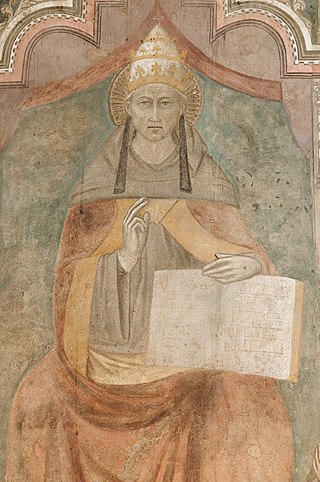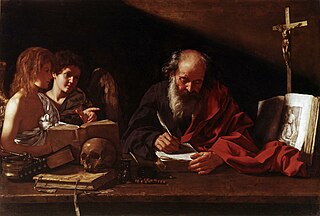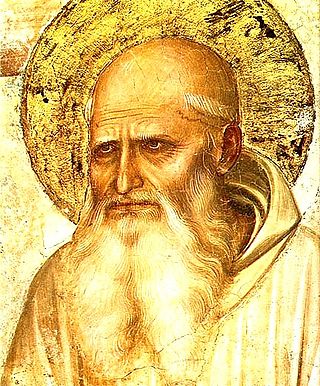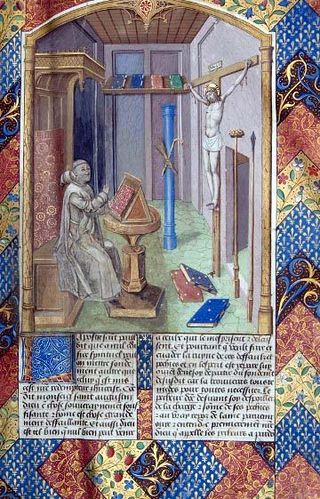
Francis Petrarch, born Francesco di Petracco, was a scholar and poet of the early Italian Renaissance and one of the earliest humanists.

Pope Celestine V, born Pietro Angelerio, also known as Pietro da Morrone, Peter of Morrone, and Peter Celestine, was head of the Catholic Church and ruler of the Papal States for five months from 5 July to 13 December 1294, when he resigned. He was also a monk and hermit who founded the order of the Celestines as a branch of the Benedictine order.

A hermit, also known as an eremite or solitary, is a person who lives in seclusion. Eremitism plays a role in a variety of religions.

Romuald was the founder of the Camaldolese order and a major figure in the eleventh-century "Renaissance of eremitical asceticism". Romuald spent about 30 years traversing Italy, founding and reforming monasteries and hermitages.

Eknath Easwaran was an Indian-born spiritual teacher, author and translator and interpreter of Indian religious texts such as the Bhagavad Gita and the Upanishads.

The Cloud of Unknowing is an anonymous work of Christian mysticism written in Middle English in the latter half of the 14th century. The text is a spiritual guide on contemplative prayer. The underlying message of this work suggests that the way to know God is to abandon consideration of God's particular activities and attributes, and be courageous enough to surrender one's mind and ego to the realm of "unknowing", at which point one may begin to glimpse the nature of God.
In the Buddhist tradition, the five hindrances are identified as mental factors that hinder progress in meditation and in daily life. In the Theravada tradition, these factors are identified specifically as obstacles to the jhānas within meditation practice. Within the Mahayana tradition, the five hindrances are identified as obstacles to samatha (tranquility) meditation. Contemporary Insight Meditation teachers identify the five hindrances as obstacles to mindfulness meditation.
Solitude, also known as social withdrawal, is a state of seclusion or isolation, meaning lack of socialisation. Effects can be either positive or negative, depending on the situation. Short-term solitude is often valued as a time when one may work, think, or rest without disturbance. It may be desired for the sake of privacy. Long-term solitude may stem from soured relationships, loss of loved ones, deliberate choice, infectious disease, mental disorders, neurological disorders such as circadian rhythm sleep disorder, or circumstances of employment or situation.
In Buddhism, kammaṭṭhāna is a Pali word which literally means place of work. Its original meaning was someone's occupation but this meaning has developed into several distinct but related usages all having to do with Buddhist meditation.

A Happy Death is a novel by absurdist French writer-philosopher Albert Camus. The existentialist topic of the book is the "will to happiness", the conscious creation of one's happiness, and the need of time to do so. It draws on memories of the author including his job at the maritime commission in Algiers, his suffering from tuberculosis, and his travels in Europe.

Dhyāna in Hinduism means contemplation and meditation. Dhyana is taken up in Yoga practices, and is a means to samadhi and self-knowledge.

Jain meditation has been the central practice of spirituality in Jainism along with the Three Jewels. Jainism holds that emancipation can only be achieved through meditation or Shukla Dhyana. According to Sagarmal Jain, it aims to reach and remain in a state of "pure-self awareness or knowership." Meditation is also seen as realizing the self, taking the soul to complete freedom, beyond any craving, aversion and/or attachment. The 20th century saw the development and spread of new modernist forms of Jain Dhyana, mainly by monks and laypersons of Śvētāmbara Jainism.

Betrachtung is a collection of eighteen short stories by Franz Kafka written between 1904 and 1912. It was Kafka's first published book, printed at the end of 1912 in the Rowohlt Verlag on an initiative by Kurt Wolff.

Philippe de Cabassole or Philippe de Cabassoles (1305–1372), the Bishop of Cavaillon, Seigneur of Vaucluse, was the great protector of Renaissance poet Francesco Petrarch.
Sir Brian William Vickers is a British academic, now Emeritus Professor at ETH Zurich. He is known for his work on the history of rhetoric, Shakespeare, John Ford, and Francis Bacon. He joined the English department at University College London as a visiting professor in 2012.

The Vita Christi, also known as the Speculum vitae Christi is the principal work of Ludolph of Saxony, completed in 1374.

Guigo I also known as Guigues du Chastel, Guigo de Castro and Guigo of Saint-Romain, was a Carthusian monk and the 5th prior of Grande Chartreuse monastery in the 12th century. He was born in 1083 near the Chateau of Saint-Romain, and entered the Grande Chartreuse in 1106.

Otium is a Latin abstract term which has a variety of meanings, including leisure time for "self-realization activities" such as eating, playing, relaxing, contemplation, and academic endeavors. It sometimes relates to a time in a person's retirement after previous service to the public or private sector, as opposed to "active public life". Otium can be a temporary or sporadic time of leisure. It can have intellectual, virtuous, or immoral implications.

The Móhē zhǐguān is a major Buddhist doctrinal treatise based on lectures given by the Chinese Tiantai patriarch Zhiyi in 594. These lectures were compiled and edited by Zhiyi´s disciple Guanding (561-632) into seven chapters in ten fascicles.

Hercules at the crossroads, also known as the Choice of Hercules and the Judgement of Hercules, is an ancient Greek parable attributed to Prodicus and known from Xenophon. It concerns the young Heracles/Hercules who is offered a choice between Vice and Virtue—a life of pleasure or one of hardship and honour. In the early modern period it became a popular motif in Western art.
















